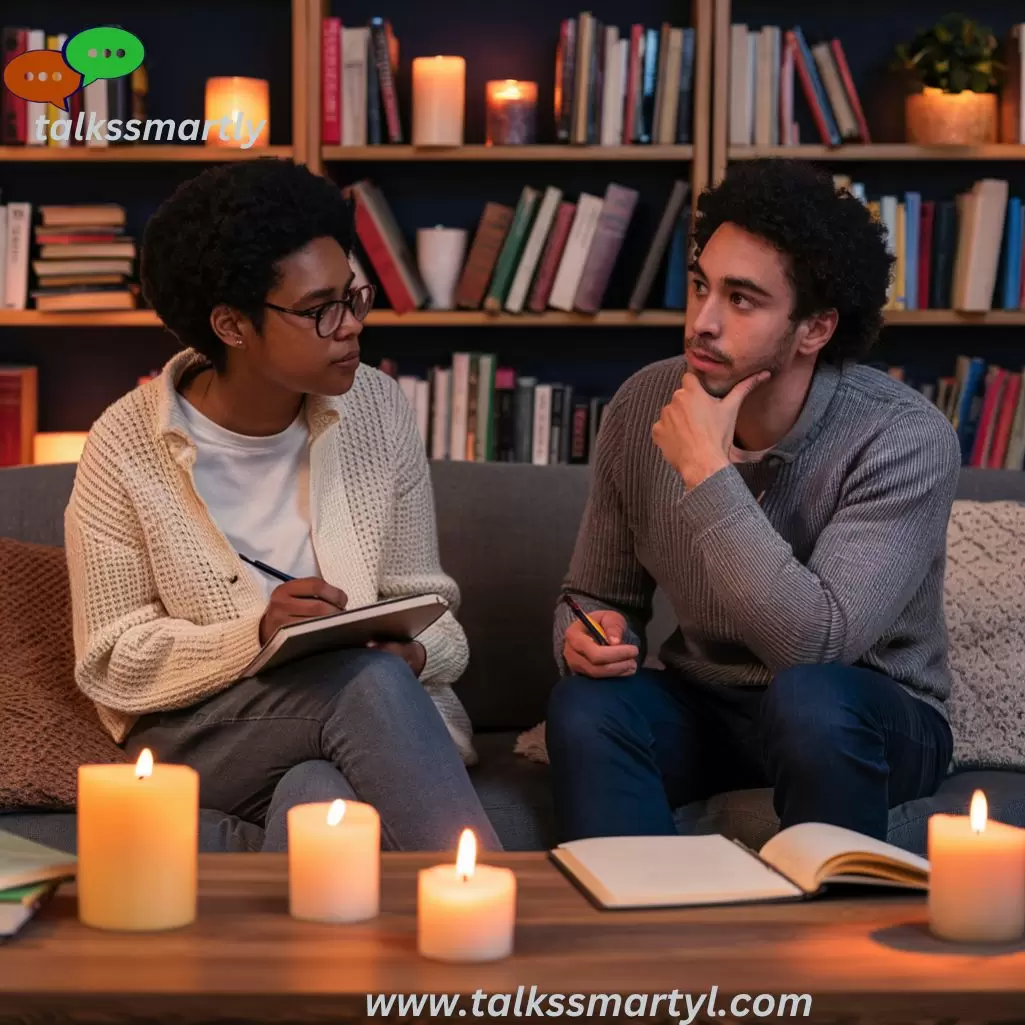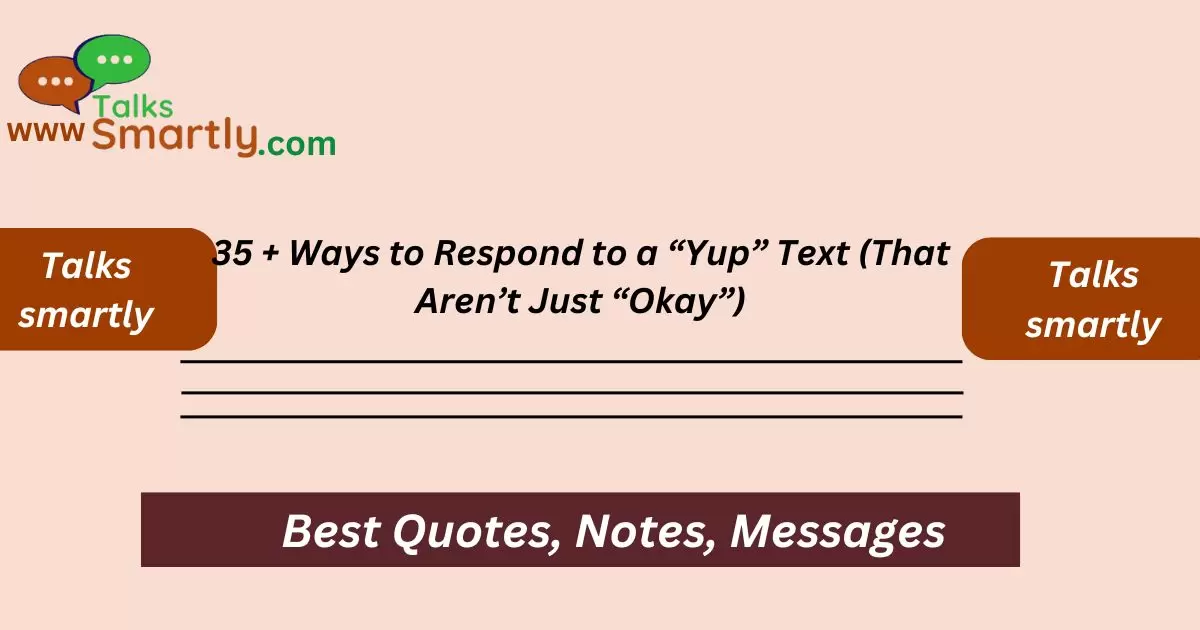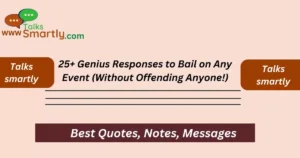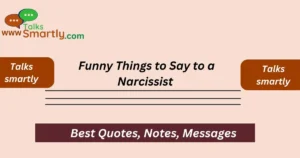Introduction
Tired of replying “Okay” to a “Yup” text? Explore fun and creative ways to keep the conversation engaging and lively with these 35+ unique responses.
Responding to a simple “Yup” text can sometimes feel challenging. Instead of just replying with “Okay,” there are many creative and engaging ways to keep the conversation going.
Whether you’re talking to a friend, family member, or colleague, having a variety of responses can make your interactions more interesting and enjoyable. This guide will provide you with 35+ different ways to respond to a “Yup” text, ensuring your replies are always fun and engaging.
Keeping the Conversation Flowing – Responses for All
1. I appreciate your insights. What do you think we should do next?
Expressing gratitude for someone’s input shows respect and encourages further discussion. By acknowledging their insights, you validate their contribution to the conversation. Asking “What do you think we should do next?” invites them to propose a course of action, keeping the dialogue proactive and collaborative.
2. Thanks for sharing your thoughts. Where do you suggest we go from here?
Acknowledging someone’s thoughts with gratitude opens up the conversation for further exploration. By asking “Where do you suggest we go from here?” you invite them to elaborate on their ideas or provide direction, ensuring the discussion moves forward constructively.
3. It’s great to hear your perspective. What’s the next step in your opinion?

Recognizing and appreciating different perspectives fosters a positive dialogue. When you ask “What’s the next step in your opinion?” you show openness to their viewpoint and encourage them to contribute to the decision-making process, promoting collaboration and shared ownership.
4. I’m glad we’re aligned on this. What’s the next move from your side?
Acknowledging alignment in understanding or agreement sets a positive tone for the conversation. By asking “What’s the next move from your side?” you reinforce the shared understanding and invite them to take initiative or suggest the next steps, ensuring clarity and momentum in the discussion.
5. Your input is valuable. What would be the next best course of action?
Valuing someone’s input emphasizes their contribution to the conversation. When you ask “What would be the next best course of action?” you demonstrate respect for their opinion and encourage them to contribute their expertise or ideas, guiding the conversation towards practical outcomes and decisions.
6. I’m on board with your ideas. What’s our next step together?
Expressing agreement and readiness to move forward strengthens collaboration. By asking “What’s our next step together?” you emphasize teamwork and shared responsibility, encouraging them to outline the next actions or decisions, ensuring clarity and alignment in moving the conversation forward.
7. Thanks for clarifying that. What’s the next step on your agenda?
Showing appreciation for clarification demonstrates attentiveness and promotes clarity in the conversation. When you ask “What’s the next step on your agenda?” you acknowledge their input and invite them to outline their priorities or next actions, ensuring mutual understanding and progress.
8. I’m glad we’re in sync. What’s our next move from your viewpoint?
Highlighting alignment in understanding or agreement reinforces teamwork and mutual understanding. By asking “What’s our next move from your viewpoint?” you recognize their perspective and invite them to contribute to the ongoing discussion or decision-making process, fostering collaboration and shared responsibility.
9. Your thoughts make sense. Where should we take this conversation now?

Acknowledging the coherence and relevance of someone’s thoughts encourages further exploration. When you ask “Where should we take this conversation now?” you validate their contributions and invite them to guide the discussion towards actionable outcomes or decisions, ensuring productive dialogue and clarity.
10. I understand your point. What should we focus on next, in your opinion?
Demonstrating understanding of someone’s viewpoint shows empathy and promotes effective communication. By asking “What should we focus on next, in your opinion?” you acknowledge their perspective and encourage them to prioritize or suggest the next steps, ensuring the conversation remains focused and purposeful.
Dude Dialect – Responses for Guys
Cool, man! What do you think about it?
- This response blends enthusiasm with a casual tone, making it suitable for conversations among friends or colleagues. It acknowledges the topic at hand and invites the other person to share their thoughts or opinions.
- For instance, if someone mentions getting a new bike, responding with “Cool, man! What do you think about it?” shows interest in their experience and encourages further discussion.
Nice one! Any thoughts on that?
- “Nice one!” is a straightforward way to express approval or admiration for something mentioned by the other person. Adding “Any thoughts on that?” prompts them to elaborate on their experience or opinion.
- For example, after hearing about a recent game someone attended, responding with “Nice one! Any thoughts on that?” encourages them to share details or their perspective on the game.
Sweet! Got any ideas on it?
- Using “Sweet!” conveys positivity and excitement, often in response to good news or plans shared by the other person. Asking “Got any ideas on it?” invites them to contribute suggestions or thoughts related to the topic.
- For instance, if someone mentions starting a new project, responding with “Sweet! Got any ideas on it?” shows interest in their plans and opens the conversation to brainstorming or discussing project details.
Rad! What’s your take on this?
- “Rad!” is a slang term meaning excellent or impressive, commonly used in informal conversations. Asking “What’s your take on this?” seeks the other person’s opinion or viewpoint on a particular subject.
- For example, if someone suggests going to the beach, responding with “Rad! What’s your take on this?” expresses enthusiasm and invites them to share their thoughts about the idea.
Awesome! Have you thought about it?
- “Awesome!” expresses admiration or approval, often in response to exciting or positive news. Asking “Have you thought about it?” encourages the other person to discuss their plans, considerations, or reflections on the topic.
- For instance, if someone mentions planning a road trip, responding with “Awesome! Have you thought about it?” shows interest in their travel plans and prompts them to share details or ideas.
Thoughtful Answers to Why Do You Want to Be With Me?
No way! What’s your opinion on that?
- “No way!” expresses surprise or disbelief in a friendly manner, commonly used to react to unexpected or interesting information. Asking “What’s your opinion on that?” invites the other person to share their thoughts or viewpoint on the topic mentioned. For example, if someone shares an unexpected encounter, responding with “No way! What’s your opinion on that?” shows curiosity and encourages them to elaborate on their experience.
Totally! Any ideas about this?
- “Totally!” affirms agreement or understanding, often used to express wholehearted agreement or acknowledgment of something mentioned. Asking “Any ideas about this?” invites the other person to contribute suggestions, thoughts, or insights related to the topic. For instance, if someone mentions watching a great movie, responding with “Totally! Any ideas about this?” shows agreement with their opinion and encourages discussion about the movie or related topics.
! Any thoughts on that move?
- “Nice move!” is a casual expression used to commend someone’s decision or action. Asking “Any thoughts on that move?” prompts the other person to reflect on their decision or action and share their reasoning or perspective. For example, if someone mentions landing a new job, responding with “Nice move! Any thoughts on that move?” congratulates them and encourages them to discuss their experience or plans related to the job.
Right on! Got any insights on it?

- “Right on!” expresses agreement or approval, often used to show enthusiasm or support for something mentioned. Asking “Got any insights on it?” invites the other person to share their observations, reflections, or knowledge about the topic. For instance, if someone mentions starting a new book, responding with “Right on! Got any insights on it?” shows interest in their reading experience and encourages them to discuss the book or share their thoughts.
Far out! What’s your perspective on this?
- “Far out!” is an informal expression used to express surprise, admiration, or excitement. Asking “What’s your perspective on this?” invites the other person to share their viewpoint or opinion on a particular subject. For example, if someone suggests planning a camping trip, responding with “Far out! What’s your perspective on this?” expresses enthusiasm for the idea and encourages them to discuss their thoughts or plans for the trip.
Gal Gab – Responses for Girls
1. Understood:
When someone says “Understood,” it indicates they comprehend what you’re saying and are ready to listen further. It invites the other person to continue sharing their thoughts without interruption.
2. Is everything okay, though?:
This response acknowledges that something might be troubling the other person, despite their outward appearance. It shows concern and encourages them to open up if they feel comfortable.
3. Tell me more:
By saying “Tell me more,” you express genuine interest in the person’s thoughts or feelings. It encourages them to elaborate and share deeper insights into their emotions or experiences.
4. I hear you:
This phrase reassures the speaker that their words are being listened to attentively. It validates their feelings and encourages them to keep expressing themselves.
5. I’m here for you:
Offering support with “I’m here for you” lets the person know they have your emotional backing. It implies readiness to help or simply to listen, depending on what they need.
6. No pressure:
“No pressure” communicates that there’s no rush to discuss things. It creates a relaxed atmosphere, giving the other person the space and time they might need to gather their thoughts.
7. Take your time:
Encouraging someone with “Take your time” shows patience and understanding. It signals that you’re willing to wait for them to share at their own pace.
8. It’s okay:
Saying “It’s okay” reassures the person that whatever they’re feeling or experiencing is acceptable to discuss. It promotes openness and acceptance in the conversation.
9. Want to chat?:
Asking “Want to chat?” invites the other person to engage in a conversation when they’re ready. It shows willingness to listen and provides an opportunity for them to initiate further discussion.
10. I’m listening:
Simple yet powerful, “I’m listening” affirms your readiness to hear what the other person has to say. It encourages them to speak freely knowing they have your full attention.
Convo Catalysts – Versatile Responses
1. Thanks for confirming! Could you also share your thoughts on…?
When someone confirms information or a decision, expressing gratitude with “Thanks for confirming!” sets a positive tone. Following up with a question like “Could you also share your thoughts on…” invites them to expand on the topic, encouraging deeper discussion or clarification. This approach not only acknowledges their input but also shows interest in their perspective, fostering a more interactive dialogue.
2. I appreciate your update! By the way, have you considered…?
Acknowledging someone’s update with “I appreciate your update!” shows gratitude and attentiveness. Suggesting “By the way, have you considered…” introduces a new idea or perspective related to the topic at hand. This dual approach shows engagement and encourages the other person to consider different angles or possibilities, keeping the conversation dynamic and insightful.
3. Great to hear! I’m curious about your opinion on…
Responding positively with “Great to hear!” signals enthusiasm and interest in the information shared. Following up with “I’m curious about your opinion on…” prompts them to share their thoughts or insights, turning a simple acknowledgment into an opportunity for meaningful exchange. This approach builds rapport and encourages mutual sharing of ideas.
4. That’s helpful, thank you! Also, I wanted to ask about…
Expressing gratitude with “That’s helpful, thank you!” acknowledges the value of the information received. Adding “Also, I wanted to ask about…” transitions smoothly into seeking further clarification or details. This dual approach shows appreciation for their input while expressing genuine interest in expanding the discussion, maintaining engagement and clarity.
5. Thanks for letting me know! What do you think about…?
Acknowledging information with “Thanks for letting me know!” shows appreciation for their communication. Following up with “What do you think about…” invites them to share their perspective or opinion on a related topic. This approach encourages active participation and demonstrates openness to their viewpoint, fostering a collaborative and inclusive conversation.
6. I’m glad we’re on the same page! Another thing I’m interested in is…
Acknowledging agreement with “I’m glad we’re on the same page!” affirms mutual understanding. Continuing with “Another thing I’m interested in is…” transitions smoothly into exploring related topics or expanding on shared points. This approach reinforces alignment while encouraging further exploration of ideas, fostering a productive and cohesive discussion.
7. Got it, thanks! Could you also give me some insight into…?
Confirming understanding with “Got it, thanks!” acknowledges clarity and comprehension. Following up with “Could you also give me some insight into…” seeks additional information or perspective on a specific aspect. This approach shows attentiveness and curiosity, encouraging comprehensive discussion and ensuring a thorough understanding of the topic at hand.
8. I understand, thanks! I’m wondering how you feel about…
Demonstrating understanding with “I understand, thanks!” acknowledges comprehension of the information shared. Continuing with “I’m wondering how you feel about…” prompts them to share their feelings or opinions on a related matter. This approach shows empathy and interest in their viewpoint, encouraging open dialogue and mutual exchange of ideas.
9. Appreciate the update! By the way, I’d like to hear your perspective on…

Showing appreciation for an update with “Appreciate the update!” acknowledges their effort and contribution. Following up with “By the way, I’d like to hear your perspective on…” invites them to share their viewpoint or insights. This approach demonstrates respect for their input and encourages them to actively participate in the conversation, fostering collaborative discussion.
10. Thanks for the confirmation! Also, I’d love to get your input on…
Expressing gratitude for confirmation with “Thanks for the confirmation!” shows appreciation for their response. Adding “Also, I’d love to get your input on…” transitions smoothly into seeking their opinion or feedback on another topic. This dual approach maintains momentum in the conversation and encourages ongoing dialogue, promoting mutual engagement and exchange of ideas.
Answer To Key Question “Ways to Respond to a “Yup” Text
Why should I use different responses instead of just saying “okay”?
Using different responses instead of just saying “okay” keeps the conversation more engaging and shows that you are interested in continuing the dialogue. It can make the interaction feel more personal and less monotonous.
What are some examples of responses I can use instead of “okay”?
Some examples include:
- “Got it, thanks!”
- “Sounds good, what’s next?”
- “Thanks for confirming! What do you think about…?”
- “Cool, any other updates?”
- “Great, how do you feel about that?”
How can I make my responses more interesting?
To make your responses more interesting, try to ask follow-up questions or share your thoughts. For example, instead of just saying “okay,” you can say, “Got it, thanks! By the way, have you thought about…?” This shows that you are engaged and interested in the conversation.
Will using different responses help build better relationships?
Yes, using varied and thoughtful responses can help build better relationships. It shows that you are paying attention and value the conversation, which can foster deeper connections and more meaningful interactions.
Are there any situations where a simple “okay” is appropriate?
Yes, there are situations where a simple “okay” is perfectly appropriate, especially if the conversation doesn’t require further discussion or if you’re in a hurry. However, when possible, using more engaging responses can make your interactions more lively and enjoyable.
Conclusion
Having a variety of responses to a “Yup” text can greatly enhance your communication skills. It shows that you are interested and engaged in the conversation, which can strengthen your relationships.
By using some of these 35+ creative responses, you’ll never have to worry about sounding repetitive or boring again. Remember, the key to good communication is to keep it lively and interesting!











